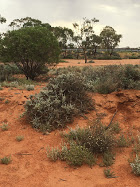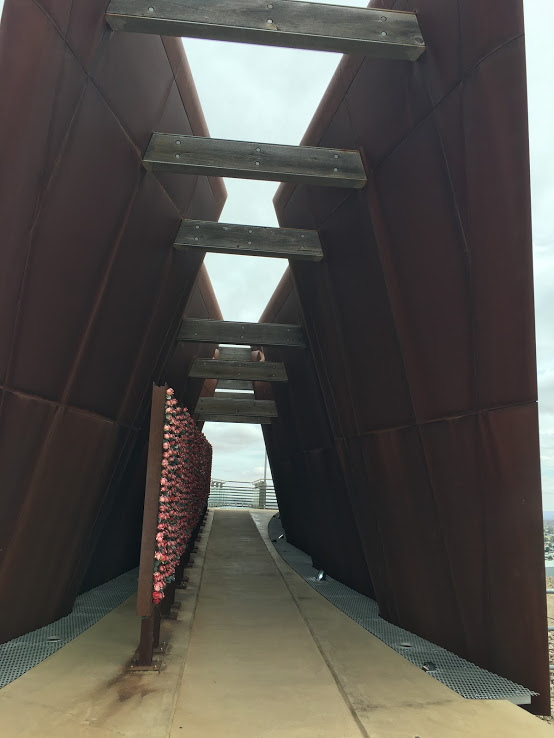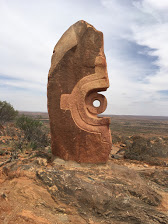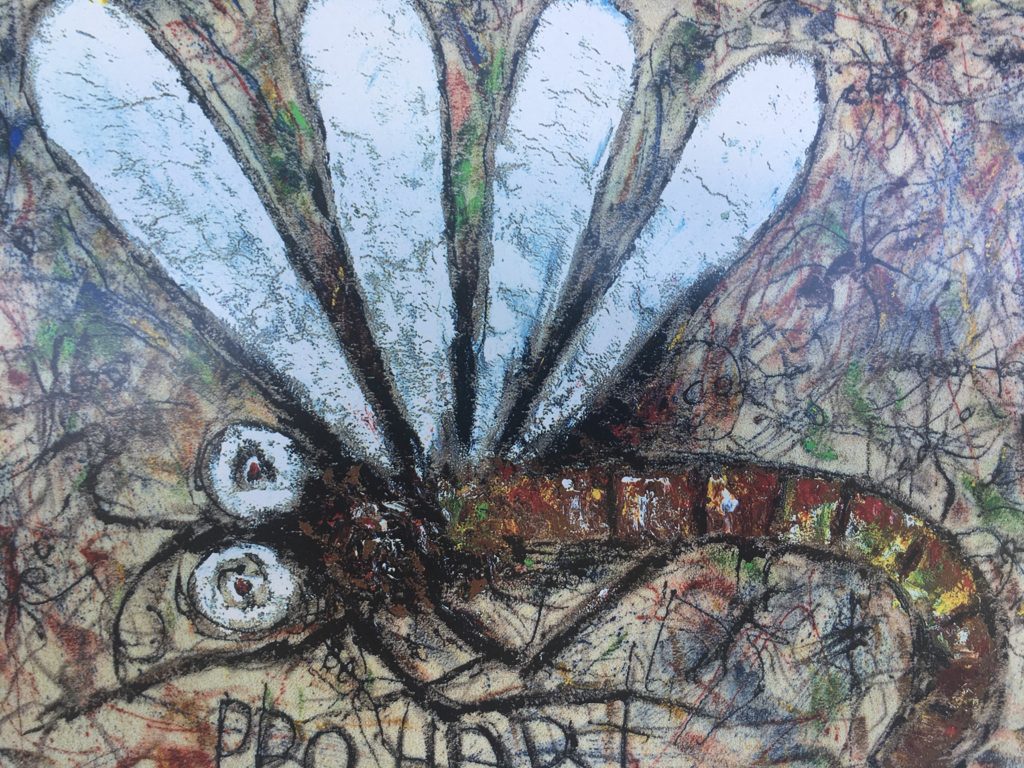After the state-wide panic of a six day Covid lockdown, our brief foray into isolation barely lasted 24 hours. A storm in a teacup? A flash in the pan? Miraculously, two days later, we were able to reignite plans to visit Bathurst for my cousin’s birthday and make a last minute dash to the border of New South Wales.

It’s our first night out, and we have landed just shy of the border, and Broken Hill. We camp on a patch of scrub in the middle of nowhere, between the railway line and the road. Barney, our new VW campervan (a very smart gentleman with blue and white checked seats and matching curtains) is already lightly coated in red dust. As we set up our deck chairs and the gas cooker, our noses and ears are promptly infiltrated by a thousand flies. Nonetheless, with a pasta sauce bubbling gently on the stove, and a glass of red wine in hand, we sit back happily, counting the wagons on the freight trains that thunder by, and waving gaily to the whooping hoots of the road trains.
The nearest township (Olary) consists of a pub and handful of scattered houses. The carcasses of a handful more (some reduced to a mere chimney), a few rusty corrugated iron sheds and a smattering of derelict cars complete the picture. Since Burra, the roadside has been littered with the white bones of roadkill. Whether kangaroos, cattle or sheep, it hard to tell, as the bones had been picked clean by crows and raptors, leaving few clues to distinguish them. Trees are an endangered species round here.
By complete contrast, we are reading a book by a friend who spent almost three years living in Mainland China. Flat, dry, scrubby dessert is replaced in our mind’s eye by vast Chinese cities, awash with sky-scrapers and immersed in smog. We try to decide if a city of nine million, awash with pollution and constant traffic jams, wins over nine million flies and mile upon mile of red dust.
It’s a little after dawn on day two. There is no thought of dawdling over cornflakes and a cup of tea. We are packing up in short order to flee the flies. By eight o’clock, we have arrived in Broken Hill for coffee and raisin toast topped with rocket. A strange choice of garnish, but the toast is delicious, full of spices and perfectly cooked, the coffee is hot, and the café is free of flies.
We have no idea what to expect of Broken Hill, knowing only that it was the home of Broken Hill Proprietary (BHP). We are surprised by wide, shady streets and many attractive stone buildings. We spend a fascinating day in this outback mining town, drifting from nature reserve to mine to art gallery, with a slight detour to Menindee, a tiny town to the south. (Note to self: it’s time to put aside European expectations. When the map suggests a large lake in the mid north, don’t expect miracles. Be grateful if it is a teacup more than a muddy puddle.)
Nonetheless, our foray south provides a fascinating spectacle of local wildlife, including a pair of emus with three gangly, long-legged, chicks in tow. A family of quail scuttle across the road in single file like school kids at a pedestrian crossing. Every few miles, a stolid, shingle backed lizard plods with suicidal determination across the hot tarmac. Down by the darling, a pair of pelicans drifted across the river, our only glimpse of running water since we drove over the Torrens, some six hundred kilometres south.

Back in Broken Hill, we drive to the top of the hill on the southern side of town, where a visitor’s centre and a memorial to 800 dead miners have been erected, overlooking the town. The memorial lists all the miners killed, plus the cause of their deaths: in rock falls or mine explosions, from gas leaks or lung disease, from toppling down mine shafts or being buried alive in mullock or skimp. It seems there were a multitude of miserable ways to die before OH&S kicked in to protect miners from such grisly ends.
On a positive note, I learned some new words:
• Mullock: a mound of waste and loose rubble left over from mining operations (or to ridicule someone by ‘poking mullock’ at them)
• Kibble: a bucket for material or men out of a shaft (or dried dog food)
• Bogger: a pneumatic shovel for removing broken rock (and dumping it into a cart that looks exactly like the ones at Gringotts)
• Skimps: sandy residue from a mine, after all the minerals have been extracted (also something to suffocated under, if you should be careless enough to fall in).

After stalking over the wasteland of mullock, and admiring the view of the town below, we head north to the Living Desert State Park, a 2400 hectare area established in 1992. It is a hot day, and we trudge begrudgingly along the walking trail, through a fenced park that features hardy local plants that can survive the bone dry soil and the bleak surroundings better than we can. On a nearby hill is a circle of twelve stones à la Stonehenge. More than fifty tonnes of sandstone blocks were lugged from Wilcannia to this remote hilltop, where a multinational group of skilled sculptors gathered in 1993 to leave their mark on the Australian outback. As one artist said at the time, the stones look so peaceful and awe-inspiring on their own, he didn’t see the need to carve into them. But they did anyway, and the results are fascinating.
Another local artist, we discover, is Kevin Charles Hart, better known to the art world as Pro Hart. He died in 2006, but the gallery he built to house his eclectic works of art is an absolute joy to visit. It’s hard to believe this talented soul had a day job in the mines, but some of his most interesting works are those reflecting the hours he spent underground.
He also experimented with a multitude of art forms, creating paint guns and even a paint canon that splattered paint onto canvas from a distance. He illustrated the conflict between white man and aboriginal in stage-like sets, and his Lowry-like scenes of town events, such as the St Patrick’s Day races and Kids Sports day. He painted outback landscapes over one of his Rolls Royce cars and created exquisite sculptures. There are extraordinary abstracts and those enigmatic masks, eucalypts and yabbies, miners and shearers, Sydney Opera House and the Adelaide Oval. And Barney is now sporting a sticker of Hart’s amazing dragonfly on carpet.

Broken Hill might be a long way from anywhere, but I’m keen to go back. Perhaps for the Broken Heel Festival in September, when the town fills up with drag queens and divas, comedy shows and cabaret, all paying homage to the glorious, glittering cult of Priscilla Queen of the Dessert…
